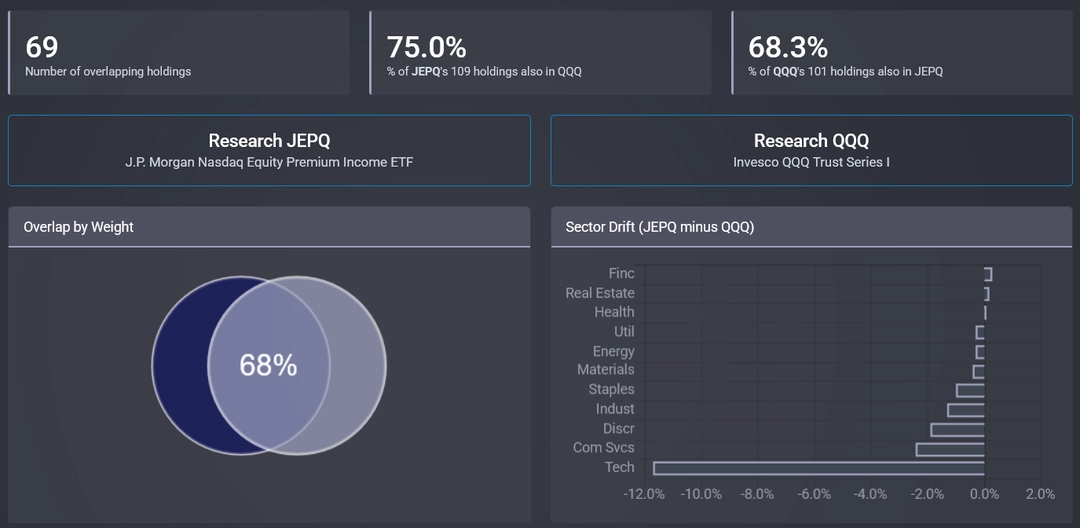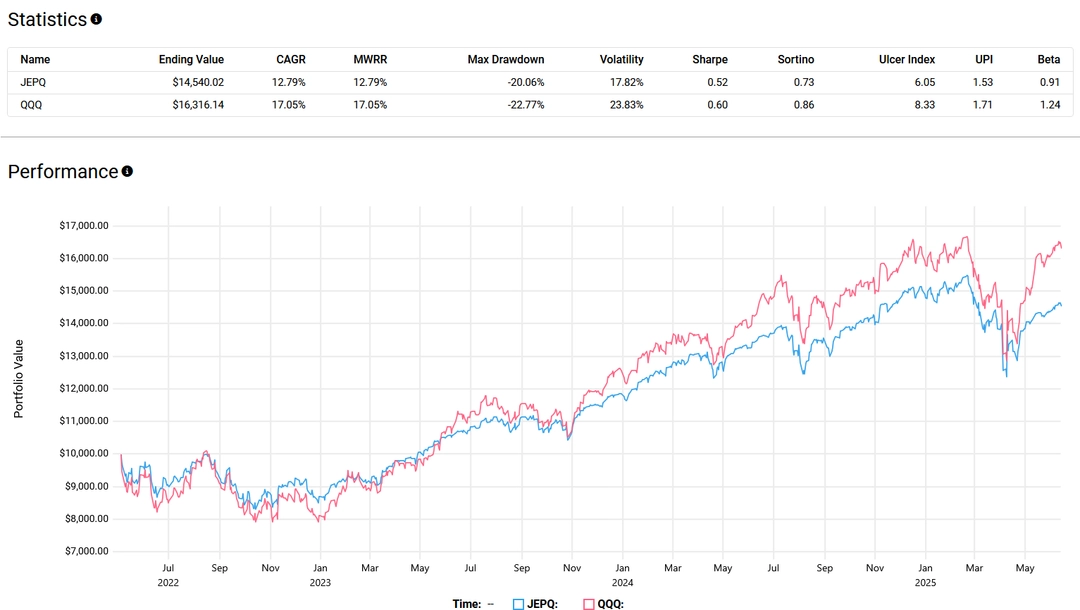Morgan Stanley identifies next wave of AI-linked "alpha"
Back in May, I reviewed the JPMorgan Equity Premium Income ETF (NYSE:JEPI) and had plenty of good things to say.
I liked its reasonable 0.35% expense ratio, historically strong risk-adjusted returns, ability to cushion downside and smooth volatility, and of course, its experienced manager. I was less impressed with its tax inefficiency, but no ETF is perfect.
So how does JEPI’s more aggressive cousin, the JPMorgan Nasdaq Equity Premium Income ETF (NASDAQ:JEPQ), stack up?
Although smaller than JEPI, JEPQ’s $26 billion in AUM still makes it a heavyweight in the covered call ETF space, and it’s already inspired a growing list of imitators from competing issuers. Here’s my take on how it performs, what it offers, and whether it deserves a place in your portfolio.
JEPQ: What I Like
A lot of this is going to sound like the same laundry list of pros I saw with JEPI—and that shouldn’t come as a surprise. JEPQ is managed by the same team, led by Hamilton Reiner.
Let’s start with fees. At a 0.35% expense ratio, JEPQ is clearly more expensive than your typical passive index ETF. But for active stock selection plus covered call writing, it’s a bargain, especially compared to the high fees often seen in the actively managed income ETF category.
The equity sleeve of JEPQ is loosely based on the Nasdaq-100, but the managers have discretion to tweak weightings and even add out-of-benchmark names.
The stated goal is to mimic the Nasdaq-100’s exposure with less volatility. JPMorgan calls this an “applied data science approach to fundamental research and portfolio construction” which, functionally, is just active management by another name.
And just like JEPI, JEPQ uses equity-linked notes (ELNs) for its covered call overlay, with up to 15% of the portfolio allocated to these instruments. These ELNs provide the return profile of writing out-of-the-money call options on the Nasdaq-100 Index.
Because the Nasdaq is so volatile, JEPQ generates a very high 14.4% 30-day SEC yield, though keep in mind that yield isn’t fixed—it rises and falls with market volatility.
So basically, if you’re looking for tech/growth exposure but want your total returns to be driven more by monthly income than by share price appreciation, JEPQ gets the job done.
JEPQ: What I Dislike
JEPI’s strategy works because the portfolio takes pains to be meaningfully different from the index it writes options on.
While JEPI sells S&P 500 index calls via ELNs, the underlying stock portfolio focuses on defensive, low-volatility names. This creates a nice barbell effect: you get consistent income from the call premiums and some downside protection from the stock selection.
JEPQ, on the other hand, doesn’t quite stick the landing. The portfolio still looks very similar to the Nasdaq-100, which means it carries the usual heavy exposure to tech and growth stocks.
Whatever tweaks the managers have made to reduce volatility haven’t had much success—and in a bull market, they’ve actually crimped performance.
From May 4, 2022 (JEPQ’s launch) to June 13, 2025, JEPQ has returned a 12.79% CAGR. In comparison, the Invesco QQQ Trust (NASDAQ:QQQ) posted 17.05%.
And while JEPQ did smooth out volatility and reduce drawdowns somewhat, the trade-off wasn’t ideal—its Sharpe ratio came in at 0.52 versus 0.60 for QQQ. So even on a risk-adjusted basis, JEPQ underperformed.
Then there’s the tax side. Nasdaq-100 stocks don’t throw off much in the way of dividends, so most of JEPQ’s eye-popping yield comes from the ELNs. And those distributions are taxed as ordinary income, which could leave taxable investors with a much larger bill come April.
Finally, there’s counterparty risk. JEPQ limits ELN exposure to 15% and uses big banks as its counterparties, which is prudent, but any time you package structured products into an ETF, it introduces a layer of complexity and risk that buy-and-hold investors should be aware of.
JEPQ: My Verdict
I like Hamilton Reiner and his team at the helm—they’ve proven themselves capable managers—and the 0.35% expense ratio is dirt cheap for an actively managed strategy that combines stock selection with covered call overlays. The double-digit yield is also attractive and has held up reasonably well since launch.
But JEPQ is held back by two structural issues. First is the counterparty risk tied to its equity-linked notes (ELNs). While capped at 15% and backed by large global banks, it’s still something to monitor.
Second is the tax treatment—because most of the yield comes from call premiums, distributions are taxed as ordinary income, which reduces after-tax returns for investors in taxable accounts.
And ultimately, the strategy that works so well for JEPI—pairing income generation with defensive equity exposure—doesn’t translate quite as effectively to JEPQ.
Trying to generate stable income from a portfolio dominated by tech and growth stocks is a tougher balancing act. It’s not a bad ETF by any means, but it doesn’t quite reach the same level of execution.
Which stock should you buy in your very next trade?
AI computing powers are changing the stock market. Investing.com's ProPicks AI includes 6 winning stock portfolios chosen by our advanced AI. In 2024 alone, ProPicks AI identified 2 stocks that surged over 150%, 4 additional stocks that leaped over 30%, and 3 more that climbed over 25%. Which stock will be the next to soar?
Unlock ProPicks AI

